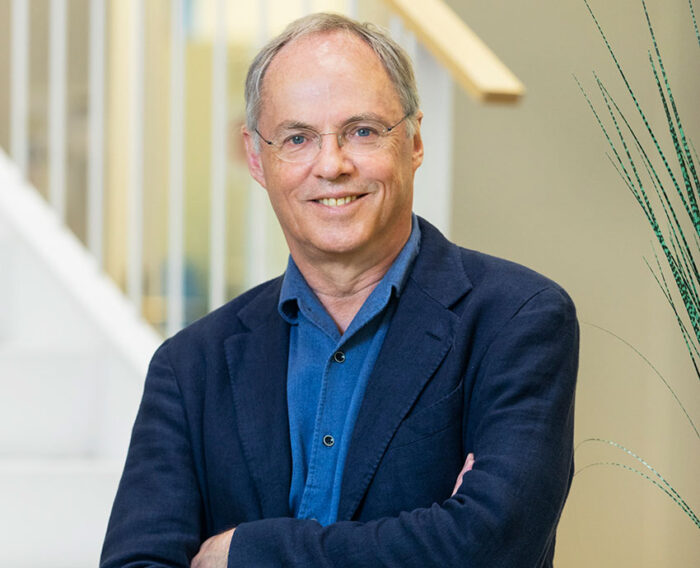
Hans Clevers will give the 2021 César Milstein Lecture at 11am (GMT) on Tuesday 30th November. This year’s lecture title is ‘Organoids to model human diseases’ and is open to anyone on Zoom.
Hans is a Professor of Molecular Genetics at Utrecht University, in addition to being a principal investigator at the Hubrecht Institute and the Princess Máxima Center for Pediatric Oncology, and an Oncode Investigator.
Hans’ work uncovered how Wnt signals control gene expression, such as through the interaction of Tcf transcription factors with the Wnt effector β-catenin. Looking beyond embryogenesis, he unveiled the role of Wnt signalling in colon cancer and in the gut epithelium. Combining these insights, he described the generic marker gene, Lgr5, which has identified multiple novel adult stem cell types. These stem cells could then be expanded indefinitely as organoids. Organoids can be described as ‘mini-organs’, and help expand our understanding of both healthy or diseased human tissue in vitro. Organoids are now widely used in basic and applied biomedicine, occupying a niche between ‘classical’ 2D cell lines and animal experimentation.
Hans studied Biochemistry and Medicine and received a PhD in Immunology from Utrecht University in 1985. This was followed by a postdoc at the Dana-Farber Cancer Institute, Boston, Massachusetts.
Hans has been a member of the Royal Netherlands Academy of Arts and Sciences since 2000. He has also been a member of the American Academy of Sciences and the Royal Society and is recognised in other prestigious roles. Hans has received multiple awards including The Breakthrough Prize in Life Sciences in 2013 for his work describing the role of Wnt signalling in tissue stem cells and cancer.
Lecture abstract
Stem cells (SCs) are the foundation of all mammalian life. SCs build and maintain our bodies throughout life. Two types of SCs are known; embryonic stem (ES) cells, which are present briefly in the early embryo a few days after fertilisation, and adult stem cells that are more specialised to the tissue they inhabit.
Every organ in our body is believed to harbour its own dedicated stem cells. These adult stem cells replace tissue that is lost due to wear and tear, trauma and disease. Adult stem cells are highly specialised and can only produce the tissue in which they reside, making them multipotent. Examples are bone marrow stem cells that make all blood cells, skin stem cells and gut stem cells. Even the brain is now known to harbour its specialised stem cells. Adult stem cells allow us to live to the high life expectancy we know of 80-90 years old. However, this comes at a cost because they are the cells that most easily transform into cancer cells.
Both types of stem cells can be used to establish ‘organoids’, 3D structures established in a dish, that recapitulate many aspects of the organ they represent. Pluripotent stem cells can be taken through the developmental steps that establish organs during embryogenesis. This has worked particularly well for parts of the central nervous system, the kidney and gastrointestinal organs. We have shown that adult epithelial stem cells carrying the generic Lgr5 marker can be cultured under tissue-repair conditions. These cells can also generate epithelial organoids directly from healthy and diseased organs such as from the gut, the liver, the lung and the pancreas. Organoid technology opens a range of avenues for the study of development, physiology and disease, for drug development and for personalised medicine. In the long run, cultured mini-organs may replace transplant organs from donors and hold promise in gene therapy.
Background information
The César Milstein Lecture is named in honour César Milstein, the LMB Nobel Laureate. This named lecture is one of a series of named lectures organised by the LMB and given by eminent scientists from around the world.
César was born in Argentina in 1927. After completing PhDs in both Buenos Aires and Cambridge, he embarked on a brief spell of research in Argentina before he joined the LMB in 1963. César then completed the rest of his career and his life in the UK.
César developed an early interest in immunology, with his research concentrated on antibody structure and diversity. In the early 1970s, he and his postdoc, Georges Köhler, developed the technique used to produce monoclonal antibodies. This work led to them being jointly awarded the 1984 Nobel Prize in Physiology and Medicine. The technique developed by César and Georges has since been developed further by LMB colleagues for therapeutic applications, leading to the creation of several MRC spin-out companies. César continued his research on how somatic mutation arises in immunoglobulin genes. He died in Cambridge on 24 March 2002.
Further references
Hans Clevers
See the Lecture on YouTube
LMB Named Lectures
Poster for the Lecture